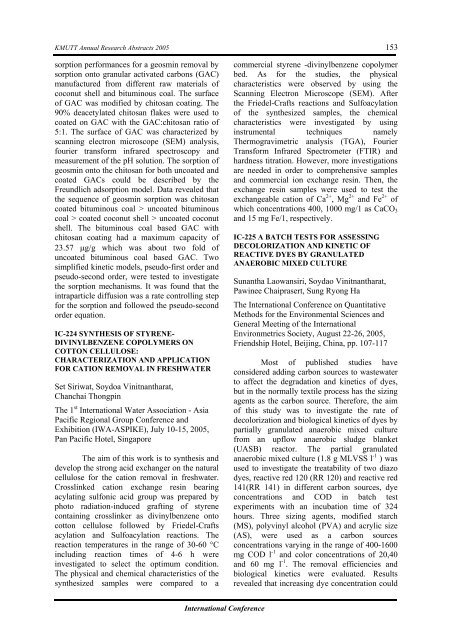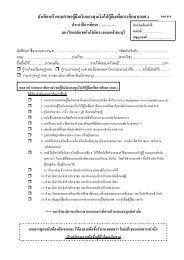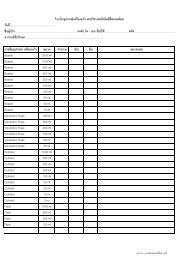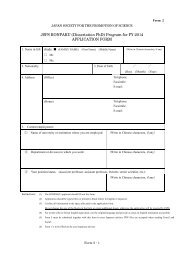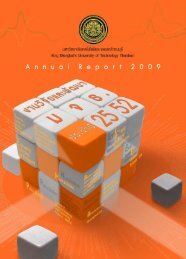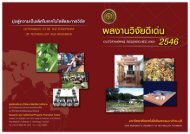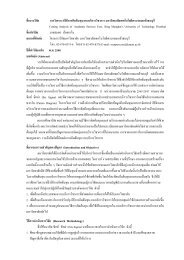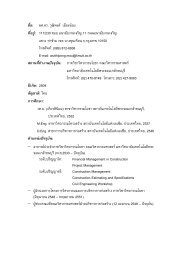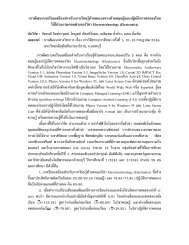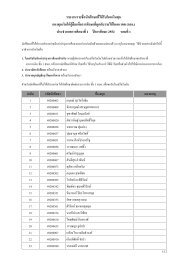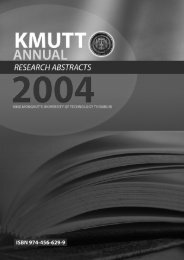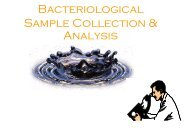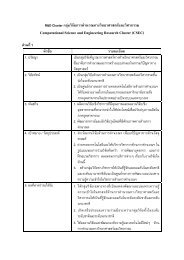You also want an ePaper? Increase the reach of your titles
YUMPU automatically turns print PDFs into web optimized ePapers that Google loves.
KMUTT Annual Research Abstracts 2005<br />
sorption performances for a geosmin removal by<br />
sorption onto granular activated carbons (GAC)<br />
manufactured from different raw materials of<br />
coconut shell and bituminous coal. The surface<br />
of GAC was modified by chitosan coating. The<br />
90% deacetylated chitosan flakes were used to<br />
coated on GAC with the GAC:chitosan ratio of<br />
5:1. The surface of GAC was characterized by<br />
scanning electron microscope (SEM) analysis,<br />
fourier transform infrared spectroscopy and<br />
measurement of the pH solution. The sorption of<br />
geosmin onto the chitosan for both uncoated and<br />
coated GACs could be described by the<br />
Freundlich adsorption model. Data revealed that<br />
the sequence of geosmin sorption was chitosan<br />
coated bituminous coal > uncoated bituminous<br />
coal > coated coconut shell > uncoated coconut<br />
shell. The bituminous coal based GAC with<br />
chitosan coating had a maximum capacity of<br />
23.57 µg/g which was about two fold of<br />
uncoated bituminous coal based GAC. Two<br />
simplified kinetic models, pseudo-first order and<br />
pseudo-second order, were tested to investigate<br />
the sorption mechanisms. It was found that the<br />
intraparticle diffusion was a rate controlling step<br />
for the sorption and followed the pseudo-second<br />
order equation.<br />
IC-224 SYNTHESIS OF STYRENE-<br />
DIVINYLBENZENE COPOLYMERS ON<br />
COTTON CELLULOSE:<br />
CHARACTERIZATION AND APPLICATION<br />
FOR CATION REMOVAL IN FRESHWATER<br />
Set Siriwat, Soydoa Vinitnantharat,<br />
Chanchai Thongpin<br />
The 1 st International Water Association - Asia<br />
Pacific Regional Group Conference and<br />
Exhibition (IWA-ASPIKE), July 10-15, 2005,<br />
Pan Pacific Hotel, Singapore<br />
The aim of this work is to synthesis and<br />
develop the strong acid exchanger on the natural<br />
cellulose for the cation removal in freshwater.<br />
Crosslinked cation exchange resin bearing<br />
acylating sulfonic acid group was prepared by<br />
photo radiation-induced grafting of styrene<br />
containing crosslinker as divinylbenzene onto<br />
cotton cellulose followed by Friedel-Crafts<br />
acylation and Sulfoacylation reactions. The<br />
reaction temperatures in the range of 30-60 °C<br />
including reaction times of 4-6 h were<br />
investigated to select the optimum condition.<br />
The physical and chemical characteristics of the<br />
synthesized samples were compared to a<br />
153<br />
commercial styrene -divinylbenzene copolymer<br />
bed. As for the studies, the physical<br />
characteristics were observed by using the<br />
Scanning Electron Microscope (SEM). After<br />
the Friedel-Crafts reactions and Sulfoacylation<br />
of the synthesized samples, the chemical<br />
characteristics were investigated by using<br />
instrumental techniques namely<br />
Thermogravimetric analysis (TGA), Fourier<br />
Transform Infrared Spectrometer (FTIR) and<br />
hardness titration. However, more investigations<br />
are needed in order to comprehensive samples<br />
and commercial ion exchange resin. Then, the<br />
exchange resin samples were used to test the<br />
exchangeable cation of Ca 2+ , Mg 2+ and Fe 2+ of<br />
which concentrations 400, 1000 mg/1 as CaCO 3<br />
and 15 mg Fe/1, respectively.<br />
IC-225 A BATCH TESTS FOR ASSESSING<br />
DECOLORIZATION AND KINETIC OF<br />
REACTIVE DYES BY GRANULATED<br />
ANAEROBIC MIXED CULTURE<br />
Sunantha Laowansiri, Soydao Vinitnantharat,<br />
Pawinee Chaiprasert, Sung Ryong Ha<br />
The International Conference on Quantitative<br />
Methods for the Environmental Sciences and<br />
General Meeting of the International<br />
Environmetrics Society, August 22-26, 2005,<br />
Friendship Hotel, Beijing, China, pp. 107-117<br />
Most of published studies have<br />
considered adding carbon sources to wastewater<br />
to affect the degradation and kinetics of dyes,<br />
but in the normally textile process has the sizing<br />
agents as the carbon source. Therefore, the aim<br />
of this study was to investigate the rate of<br />
decolorization and biological kinetics of dyes by<br />
partially granulated anaerobic mixed culture<br />
from an upflow anaerobic sludge blanket<br />
(UASB) reactor. The partial granulated<br />
anaerobic mixed culture (1.8 g MLVSS l -1 ) was<br />
used to investigate the treatability of two diazo<br />
dyes, reactive red 120 (RR 120) and reactive red<br />
141(RR 141) in different carbon sources, dye<br />
concentrations and COD in batch test<br />
experiments with an incubation time of 324<br />
hours. Three sizing agents, modified starch<br />
(MS), polyvinyl alcohol (PVA) and acrylic size<br />
(AS), were used as a carbon sources<br />
concentrations varying in the range of 400-1600<br />
mg COD l -1 and color concentrations of 20,40<br />
and 60 mg l -1 . The removal efficiencies and<br />
biological kinetics were evaluated. Results<br />
revealed that increasing dye concentration could<br />
International Conference


